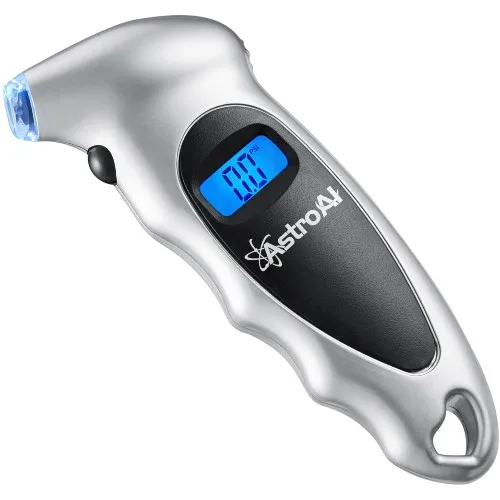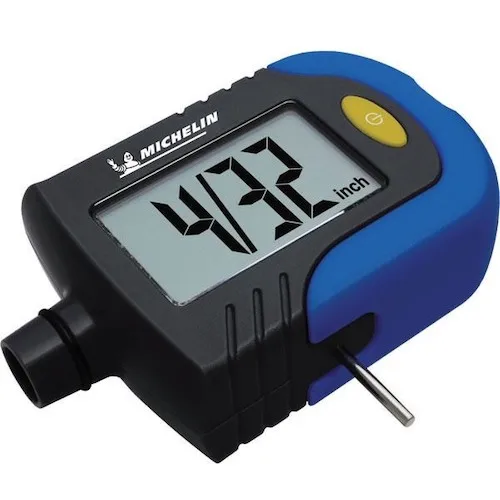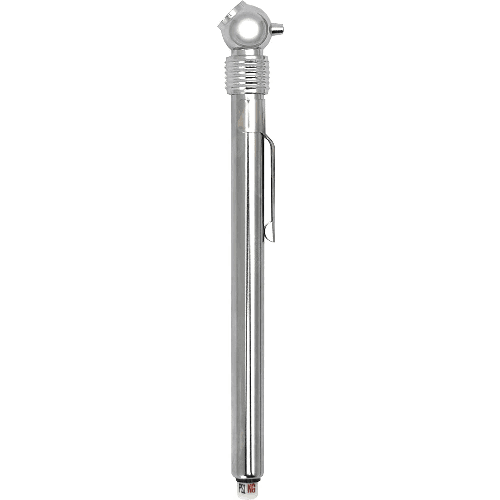Top Pick for
Overall tyre pressure gauge

Top Pick for
Overall tyre pressure gauge

Top Pick for
Digital tyre pressure gauge

Top Pick for
Cheap tyre pressure gauge

Top Pick for
Analog tyre pressure gauge

A tyre pressure gauge gives accurate measurement of the pressure inside your tyres. It's a handy tool that lets you check your tyre pressure every month. It also helps ensure that your vehicle is properly maintained and in good, running condition.
When finding the right tyre pressure gauge, consider if you want a digital, pencil or analog option. Digital models are the most popular because of their ease of use and accurate readings. You might also want to consider your vehicle type, the model's pressure and temperature range and size.
For this list, we evaluated numerous tyre pressure gauges found on Amazon. We picked models based on customer reviews and ratings. We also chose the units for each category based on key product features, such as value for money, ease of use, pressure and temperature range and size.
Read more detail on our methodology below.

We picked the AstroAI Digital Tire Pressure Gauge as the best overall tyre pressure gauge you can get online. On Amazon, it has a rating of 4.4 out of 5 stars from over 39,000 reviews.
AstroAI's tyre pressure gauge features a backlit LCD screen and a lighted nozzle for ease of use. The brand says it is designed to maintain the correct tyre pressure and reduce tyre wear. Additionally, it has 4 settings, ranging from 0-150PSI / 0-10 Bar / 0-10Kgf/cm² or 0-1000KPA. It also measures accurately with readings in 0.5 increments.
Customers praised the product's ease of use, value for money and accuracy. While the nozzle has a loose fit, it still helps in gauging tyre pressure without any problem. The blue light feature is also handy when it's dark, according to reviews. However, a few others didn't like the flimsy plastic body.

With a rating of 4.3 out of 5 stars on Amazon, we recommend Michelin's Digital Tyre Tread Depth & Pressure Gauge with LCD as the best digital option.
This Michelin tyre pressure gauge automatically turns on when placed on the tyre's valve. It also automatically switches off after 10 seconds and features an easy-to-read LCD and LED torch. The gauge has an accuracy of +/- 1% and a range of 5-99 PSI in ½ lb units.
Numerous buyers were impressed by the gauge's easy readout and versatility. It gives accurate readings when used on both cars and motorcycles. The nozzle has a snug fit on tyre valves as well. It's a bit bulkier and heavier than other tyre pressure gauges, but the size is still portable enough to carry around.

When it comes to the best analog tyre pressure gauge, we selected the Longacre 52-52004 0-60 PSI Tire Pressure Gauge. Customers on Amazon gave it a rating of 4.6 out of 5 stars.
Featuring a 2" glow in the dark dial face and a high flex house, this analog tyre pressure gauge offers quick and accurate pressure readings for cars and motorcycles. It has a high flow air pressure release button that helps drop the pressure to the desired level and reduce pressure in overinflated tyres.
At over $60, this option is a bit pricier than other models, but users said it's a worthwhile investment to ensure your tyres are properly inflated. While the analog function takes a bit of getting used to, reading is a breeze. The high flex hose includes both an angle and ball chuck for added convenience, too.

Our pick for the best pencil option is the Draper 51536 Tyre Pressure Gauge, which has a rating of 4.1 out of 5 stars.
This Draper tyre pressure gauge has graduated 6-50 PSI increments of 1 PSI. It also has an in-line feature, allowing access to hard-to-reach tyre valves. Additionally, the gauge has a valve remover and pocket clip.
Customers gave positive feedback on the gauge's ease of use and value for money. The operation is straightforward, giving accurate results in no time. The pencil design is also lightweight and extremely portable. A few customers said the gauge's readings are a bit inconsistent, but this seems to be an isolated issue.

ProTyre's gauge is a heavy-duty pencil gauge that produces accurate readings for your cars. It reads both in kilopascal and pounds per square inch. It is also pocket-sized and has a pen clip for better portability.
The general sentiment is that this is a heavy-duty but affordable option for both professional and personal use. The size is small enough to store in the glove compartment for convenience. It also gives accurate readings, but some reviews said it has a bit of a learning curve.

For motorcycles, we recommend ProTyre's RG2712 0-60psi Stetho Tyre Gauge as the best model. It has a rating of 4.9 out of 5 stars on Amazon.
This mechanical tyre pressure gauge gives instant and accurate readings that are easy to read in the pointer. Made of high-quality zinc alloy and metal material, it is quite heavy and durable. It also has a built-in bleed valve that helps minimise the pressure of over-inflated tyres, while the 360º rotating chuck with a 45º angle head helps easily test tyre pressure.
Many reviewers were highly impressed by the gauge's user-friendliness, versatility, and heavy-duty build. It is also reasonably priced, allowing you to check your tyre pressure for safe driving without breaking the bank. It is suitable for motorcycles, cars, trucks and bikes as well. However, it's a bit heavier than digital and pencil tyre pressure gauges on the market.
For this list, we looked into hundreds of tyre pressure gauges listed on Amazon Australia. We picked models from the following brands:
We narrowed down our choices based on customer ratings and reviews from the past year. We also considered each model's key product features, price, ease of use and number of measurement ranges. We came up with what we believe are the 6 best tyre pressure gauges you can buy right now in Australia.
A tyre pressure gauge is used to give you an accurate measure of the pressure inside your tyres. Buying a tyre pressure gauge comes at a small price for the convenience of getting your tyre pressure checked reliably every month. Ensure you properly maintain your vehicle with our handy car maintenance tips.
Every car owner should own a basic pressure gauge. It is recommended that drivers check their tyre pressure using a tyre pressure gauge and refill at least monthly. Making sure that your tyres are not under- or over-inflated is important to maintain safe driving conditions, reduce fuel wastage costs and prevent permanent tyre damage. Under-inflated tyres can lead to faster and more uneven tyre wear. The excess heat built up while driving can even result in dangerous tyre failure.
You can check your tyre pressure at petrol stations. However, the gauges at petrol stations are often weathered or damaged and may provide inaccurate readings.
If you don't want to read your tyre pressure yourself, it is recommended to get an expert to check for you. If you are worried that your tyre could get punctured or burst on the road, check out our guide to tyre and rim insurance to see what could be covered.
A tyre pressure monitoring system is only there to warn you of a tyre puncture or active air leak. The low-pressure warning light will only be activated when your tyre pressure is 25% below the vehicle's recommended level. You can't tell just by looking at your tyre whether it's under-inflated. If it does look under-inflated, it could be dangerously under-inflated. This is not a substitute for regularly checking your tyre pressure with a tyre pressure gauge to ensure it is maintained at the optimal level.
For more information, check out our guide to tyre pressure monitoring systems.
There are 3 types of tyre pressure gauges: analog, digital and pencil.
Analog gauges, also known as dial gauges, resemble a round clock face with a simple needle that indicates the pressure and use a calibrated spring. More-advanced versions often have a glow-in-the-dark dial, a rubber cover to protect from accidental drops and 360º swivel chuck that makes it easy to access your valve stems.
Digital gauges have an electronic LCD display similar to an electronic calculator and are simple to use.
Pencil or stick-type gauges resemble a ballpoint pen and are small, light and compact.
| Type | Best for | Pros | Cons |
|---|---|---|---|
| Analog |
|
|
|
| Digital |
|
|
|
| Pencil |
|
|
|
For most people, the deciding factor will be how much you are willing to pay for a tyre pressure gauge. A basic pencil gauge could cost just $6, while a high-end multipurpose gauge could cost you $50 or more. Generally, gauges will all come with similar basic features and as long as they are accurate, they will do the job.
When looking for a pressure gauge, consider the following essential factors:
Professionals and car enthusiasts generally opt for a heavy-duty mechanical gauge which is durable and doesn't require battery replacement.
A digital gauge is easy to read from an LCD display and will usually offer the most-accurate readings.
If you have a truck or RV, it might be useful to choose a gauge with a specialised long-stemmed neck design to make gauging easy and simple. For accuracy and portability, a compact digital gauge may be the best tool for bicycle and motorcycle users.
Some gauges have a limited pressure range only up to 60PSI, so check that your gauge can test a higher inflation pressure suitable for your vehicle. Keep in mind, some RV tyres could be inflated to 100PSI.
Check the tyre pressure gauge is compatible with your vehicle's valve type. For example, some digital gauges are not compatible with Presta stems, commonly used in bicycle tyres.
Consider how compact and portable you need your gauge to be. Some gauges can fit in your pocket or glove box, while others will need to be stored in the boot of the car or your garage.
For 4x4s, it's essential that your gauge can withstand changes in temperature, pressure, altitude or humidity to provide accurate readings when driving off-road and altering load and tyre pressures for different situations.
Look for a tyre pressure gauge that can read accurately at both lower and higher pressures suitable for your vehicle. Ensure your gauge allows for easy removal of the valve core for quick tyre deflation. A large, easy-to-read backlit display would also be handy so you can read and adjust tyre pressures quickly on the road.



These are the best car roof racks you can buy right now in Australia.
These are the best tyre pressure monitoring systems you can buy right now in Australia.
How to choose a car GPS that best suits your needs.